 |
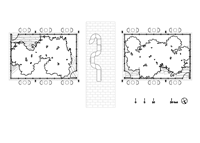 |
 |
 |
The courtyards flank either side of the building’s main entryway within the center of the office workspaces. Though physically separate, they were conceived of as one continuous space. (Image courtesy of Michael Van Valkenburgh Associates, Inc.) |
 |
 |
 |
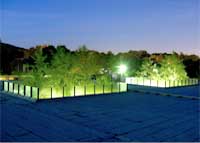 |
 |
 |
Trees poke up above the cut in the roof hinting at the garden within. Even at night the courtyards add warmth to the heart of the building. (Photo courtesy of Voorsanger & Associates Architects, P.C. ) |
 |
 |
 |
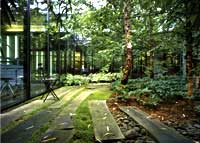 |
 |
 |
By avoiding bold design moves, the courtyards allow the textural qualities of the materials to become the focus, lending the spaces a simple, resonant beauty. (Photos by Paul Warchol) |
 |
 |
 |
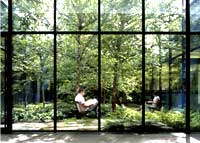 |
 |
 |
The gardens invite participation, offering the chance to see the sun, feel the breeze, and enjoy seasonal change only a few steps from the workplace. (Photos by Paul Warchol) |
 |
 |
 |
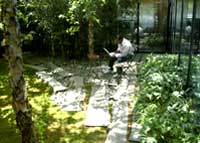 |
 |
 |
Solar orientation largely determined the location of the black locust logs. There locations provide both a shaded seating terrace in the summer and a sun-washed seating terrace in the winter. (Photo by Jerry Speier) |
 |
 |
 |
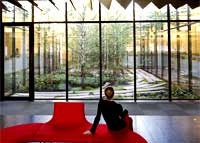 |
 |
 |
 Positioned between the two courtyards, the main entryway becomes a space for passive contemplation. The glass walls provide sightlines from the desk spaces beyond. (Photos by Elizabeth Felicella) Positioned between the two courtyards, the main entryway becomes a space for passive contemplation. The glass walls provide sightlines from the desk spaces beyond. (Photos by Elizabeth Felicella)
|
 |
 |
 |
 |
 |
 |
 |
 |
 |
|
Click here for printer-friendly version |
 |
These designs reaffirm that landscape architects can apply good design to a small commission to viscerally transform the work environment of hundreds of people. These tiny courtyards bring sunshine and snowstorms into the daily life of this workplace, using a mere 2,000 square feet of green cut into 225,000 square feet of suburban work space.
We feel that the Tahari project warrants ASLA recognition for the following reasons: we showed how good design that is not overly object oriented can create a feeling of boundlessness; we created a great design on a small budget; and we chose to work with the tactile and sensual qualities of materials and their placements to reinforce microclimatic differences in the courtyards—creating a terrace in the western courtyard where it is sunny in winter, and a second terrace on the opposite side of the other courtyard where it is shaded in summer. A “river” of logs, cut flat to work as walking surfaces, connect the two courtyards in both gesture and materiality. The pattern of logs, harvested locally, widens out to create sitting terraces and add an innovative abstraction of a forest floor to the design.
The courtyards were created by cutting away the roof and structure to allow the sky and the weather to penetrate deep within the building. The landscape architects worked with the architects to place the two courtyards such that they are almost the first thing you experience once you arrive inside the work environment.
The fashion designer Eli Tahari hired us to add the soothing and life-improving qualities of a landscape to a one-story, windowless suburban "box" he was renovating to relocate 300 warehouse and accounting staff. Mr. Tahari's work spaces in New York City are renowned for unusual uses of landscape and sensuous materials to make good places to work. He hired us to add that feeling to an otherwise hostile suburban building type. The glass-enclosed courtyards created an expansive and boundless experience to either pass by, look at, or occupy as part of the everyday life of the workplace.
This project shows how giving up just one percent of the floor area transforms the feeling of the work environment, and since tens of millions of Americans spend their days in similar settings, we feel it provides an important example. Moreover, the budget was not large.
 |
Project Resources |
|
 |
Architect:
Voorsanger & Associates Architects, P.C.
Landscape Contractor:
John Mini Distinctive Landscapes
Moss Consultants:
Sticks and Stones Farm |
 |
 |
 |
Black Locust Supplier:
Next Generation Woods, Inc.
Specimen River Birch Supplier:
Red Hill Nursery
Bamboo Consultant:
Susanne Lucas
Lighting Consultant:
L’Observatoire & Halie Light International |
 |
 |
 |
|
|
|
|
 |
 |
 |
 |
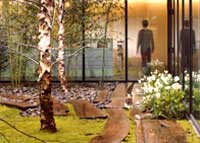 |
 |
 |
Bursts of color brighten the experience both outside and inside. Observing seasonal change becomes a daily experience facilitated by the planting palette of river birch, narcissus, hellebore, autumn fern, and yellow groove bamboo.) (Photos by Elizabeth Felicella) |
 |
 |
 |
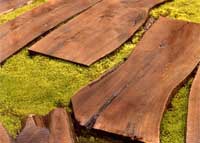 |
 |
 |
Following the placement of the 6 inch thick black locust logs, the Woodsy Mnium moss was laid upon impregnated moss topsoil juxtaposing its malleable texture with the dense un-planed surface of the logs. (Photos by Elizabeth Felicella) |
 |
 |
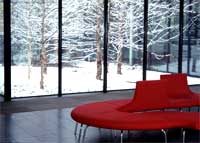 |
 |
 |
Winter penetrates deep into the heart of the building. The snow coats the ground and the branches of the trees, revealing textural qualities still evident during dormancy. (Photos courtesy of Michael Van Valkenburgh Associates, Inc.) |
 |
 |
 |
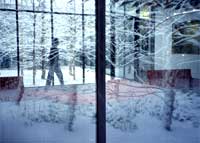 |
 |
 |
Even in winter the two courtyards connect across the main entryway, enabling sun and snow to become a part of daily life. (Photos courtesy of Michael Van Valkenburgh Associates, Inc.) |
 |
 |
 |
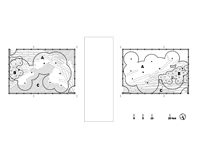 |
 |
 |
The layers of materials and plants connect the two courtyards into one intimate space while complimenting the seasonal qualities of the design. (Image courtesy of Michael Van Valkenburgh Associates, Inc.) |
 |
 |
 |
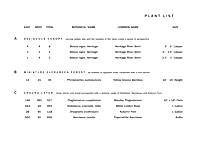 |
 |
 |
Through the use of common planting materials, we were able to create an intimate garden that injects life into a sprawling warehouse and office complex. (image courtesy of Michael Van Valkenburgh Associates, Inc.) |
 |
 |
|
 |